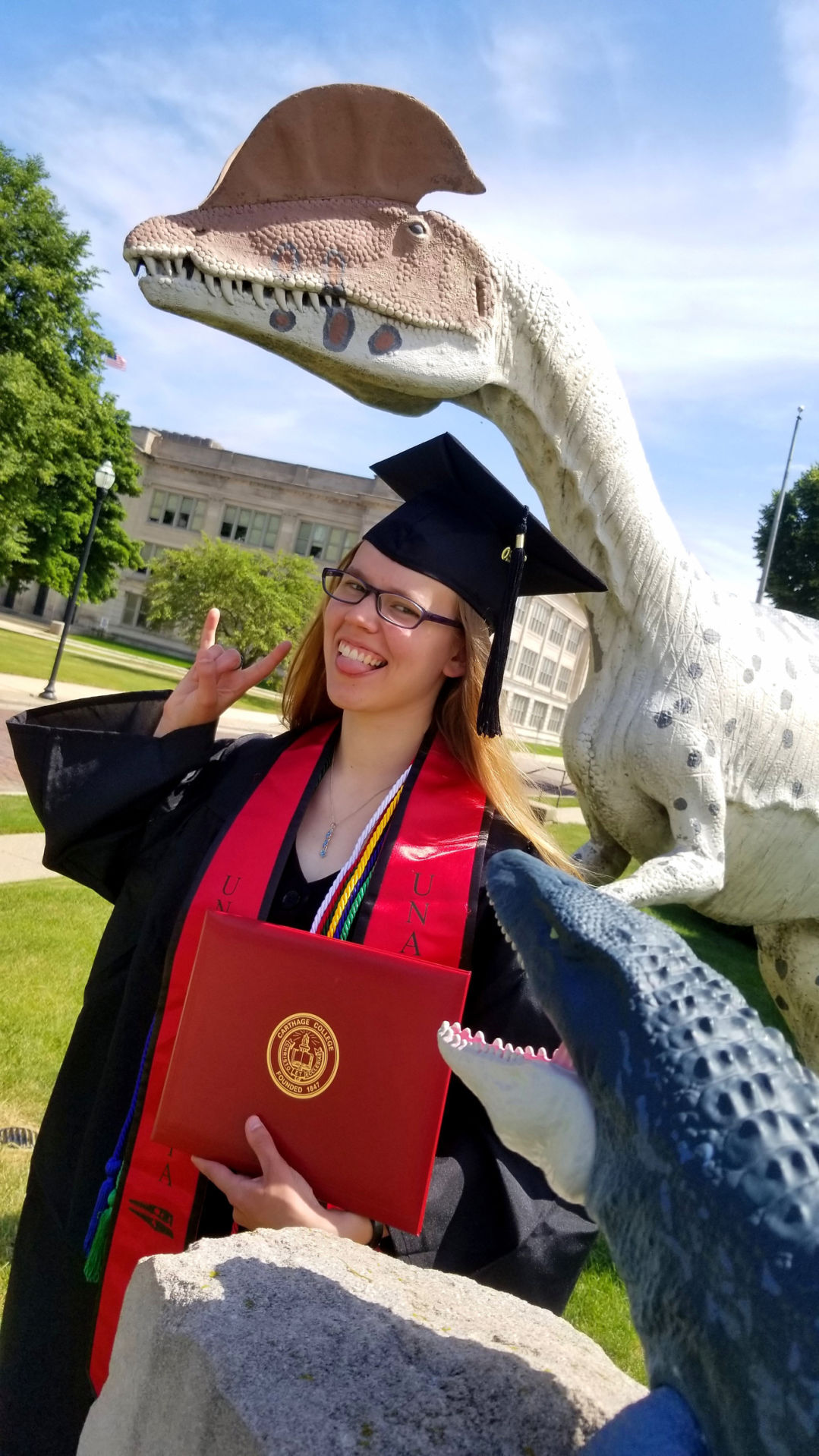THERE IS MORE TO KENOSHA THAN KYLE RITTENHOUSE
Our Jurassic worldCarthage College graduate Amelia Zietlow forges career studying sea monsters
Liz Snyder
Jul 6, 2021

Carthage College graduate Amelia Zietlow poses with some prehistoric pals outside the Dinosaur Discovery Museum in Downtown Kenosha.
Amelia Zietlow, Photo submitted

This skeleton of an ancient "sea monster," known as a mosasaur, can be found at the American Museum of Natural History in New York City. Carthage College graduate Amelia Zietlow is working and studying at the museum.
Photo submitted by Amelia Zietlow
"Bunker" is the nickname for KUVP 5033, located at the Kansas University Museum of Natural History. This is one of the largest mosasaurs found so far, at 45 feet long. That's larger than any T. rex, according to Carthage graduate Amelia Zietlow, who is studying the ancient sea creatures.
Amelia Zietlow has a very good reason for studying ancient sea monsters: They’re awesome!
The 2020 Carthage College graduate “fell into paleontology” during college.
Her first plan was “to major in business, so I could eventually afford flight school and become a pilot,” she said. “Paleo was nowhere near my radar as a potential career.”
It’s certainly on her radar now.
Zietlow is working at the American Museum of Natural History in New York, where she is also “a Ph.D. student in the Comparative Biology program. It’s more like a job than school, because they pay us, instead of the other way around.”
She’s set to graduate in the summer of 2024. Until then, she’s taking courses, working on her research and will be a teaching assistant.
“When I don’t have classes,” she added, “my days typically involve a lot of reading and/or writing, or, on the more fun days, poking around in the collections and looking at lots of fossils to figure out how they differ from one another. Basically, I get paid to think a lot about lizard bones.”
Life with mosasaurs
Zietlow focuses on mosasaurs, a group of extinct, large marine reptiles — basically, sea monsters.
In addition to just being plain awesome — and fearsome — Zietlow said the ancient predators “are better than most prehistoric animals for studying big-picture questions about biology.”
Here’s why:
“Mosasaur ancestors lived on the land and evolved adaptations to live in the water over time,” Zietlow said. “We actually have a really good fossil record of their evolution, tracking their transition from small, semi-aquatic, monitor lizard-like animals to the giant, shark-like, fully marine apex predators that get all the attention in movies and documentaries.”
That means “we can actually see how their skeletons changed as they made this transition from land to water and compare the changes in them to changes in other animals that independently made the same transition,” including whales, seals and sea turtles.
Mosasaurs also “have close living relatives — they are actually just giant aquatic lizards,” closely related to monitor lizards, snakes and iguanas.
“What’s great about this is we can do experiments in these living animals that we can’t do in extinct ones — like studying their DNA,” Zietlow said, “and because of their close evolutionary relationship, what we find in the living lizards can be applied to our understanding of mosasaurs.”
Another plus for studying mosasaurs: We have lots of their fossils, Zietlow said.
“That’s great, because a large sample size is important for answering questions that require statistics,” she said.
And being plain awesome, she added, isn’t just a fun bonus. It can have value, too.
“It means that people are more likely to engage with the research done on mosasaurs,” she said, “and get excited about lizards, evolution, biology and paleontology more generally.”
A published scientist
Though Zietlow is a recent college graduate, she’s already a published scientist — a rare feat she attributes to “a lot of things that came together.”
She gives credit to her advisors and professors at Carthage — in particular, Thomas Carr, director of the Carthage Institute of Paleontology, who “proofread what’s probably an unfathomable number of drafts” — and mentors from her internship at Marquette University.
Zietlow’s paper was first submitted as an Honors Thesis at Carthage, which she then reworked for publication.
She’s now working on a second publication, this one focusing on gecko embryos, and will be heading out July 16 to spend a week in Montana on a dinosaur dig with Carr and other students.
On that dig, Zietlow said, “it would be cool to find a rare dinosaur, and I know how much Dr. Carr would love to find a nice T. rex skeleton. Even though the odds are low, I would also, of course, love to find a mosasaur. We find a lot of fossils of animals that lived in a river, and, in addition to being super cool, a mosasaur in that environment (freshwater, far away from any sea) would be scientifically significant as well, since there is only one definitively freshwater mosasaur that we know of so far.”
Competitive field
As for Zietlow’s career plans, she would “ideally like to wind up working at a museum, where I have the resources to continue to do my own research as well as opportunities to participate in education and outreach.”
However, she cautions, “Academia and paleontology are both incredibly competitive and unpredictable fields to work in, so it’ll depend on what opportunities come my way.”
As for aspiring scientists, Zietlow’s advice is “to have a genuine interest in the scientific questions you want to answer. Careers in science, especially in research, can be really intense, but if you really love the things you’re studying, you won’t mind putting in the effort it takes to make your work the best it can be.”
No comments:
Post a Comment